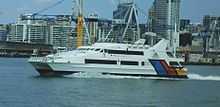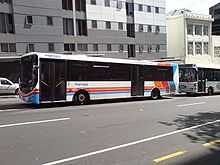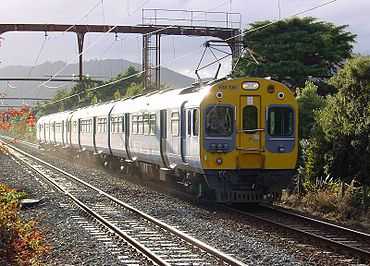Public transport in New Zealand

Public transport in New Zealand exists in many of the country's urban areas, and takes a number of forms. Bus transport is the main form of public transport. Two major cities, Auckland and Wellington, also have suburban rail systems which have been gaining more patronage and new investment in recent years. Some cities also operate local ferry services. There are no remaining tram (i.e. light rail) systems active anywhere in New Zealand (except for some museum systems and a tourist-oriented service at Wynyard Quarter in Auckland), though trams (and their horse-drawn pedecessors) once had a major role in New Zealand's public transport.
Usage
According to the Ministry for the Environment, the overall use of public transport in New Zealand is low, with only around 2.5% of trips making use of it.[1] This figure is for the whole of New Zealand and includes centres that may have limited public transport. New Zealand was rated only 22nd in a survey for public transport use amongst 28 countries worldwide, with only 56% always, or sometimes, using public transport to reach work. At the same time, this share was much higher than for example in the US, with only 34% usage.[2]
Considering the regions like Auckland, where the overall share is about 5%,[3] this figure is comparable to numerous North American and Australian cities.[4] However, use of public transport is higher in major cities, which have more developed systems. According to the 2006 census, 17% of Wellingtonians took public transport to work, as did 7% of Aucklanders.[5] Wendell Cox, public policy consultant said in 2001 that Auckland's "public transport's downtown work trip market share is 31%" compared to Wellington's 26%. Cox further stated that no other centre in New Zealand achieved as high a market share as the Auckland city centre.[6]
Modes
Buses are the most common form of public transport in New Zealand, making up the majority of trips in every city that has public transport (and often being the only public transport mode available). They are followed by trains, which are found in Wellington and Auckland. Ferries also play a role, mainly in Auckland but also in other cities. Trams in New Zealand, while once common in many cities and towns, now survive only as heritage displays. Cable cars have also been employed; the Dunedin cable tramway system was both the second and second-last to operate in the world, while the Wellington Cable Car is now a funicular.
Provision by area
Auckland


Public transport in Auckland is managed by the Auckland Transport (set up by the regional council) under the MAXX brand. It consists of buses, trains, and ferries. The Auckland public transport system is New Zealand's largest by total passenger volume, although not by trips per capita.
Buses are the most widely used form of public transport in Auckland. They are operated by a number of companies, including NZ Bus (operating under various brands) and Ritchies Transport. The route network is dense, covering all parts of the Auckland urban area (including Waiheke Island).
Auckland also has a commuter rail system, one of two in the country. The system uses diesel-powered trains, although electrification the Auckland network will see electric trains come into operation in 2014. There are three main lines, designated Western, Southern, and Eastern, as well as the shorter Onehunga line and Manukau spur. The trains are operated by Veolia's New Zealand branch.
Ferries also play a significant role in Auckland's transport network — more so than in other New Zealand cities. Ferries travel between the city centre and a number of destinations, including several points on the North Shore, Half Moon Bay, Waiheke Island, Rangitoto Island, and Great Barrier Island. The largest operator is Fullers Ferries.
Auckland, like many others in New Zealand, previously operated trams. The first ran in 1884, and the last ran in 1956. The Museum of Transport and Technology subsequently constructed a 2 km heritage line linking its two sites and Auckland Zoo. A tourist-oriented tram service has operated at Wynyard Quarter since 2011.[7]
Christchurch
The Christchurch public transport system is based principally around buses, although the city also has a ferry service and a heritage tramway. The services are operated under the Metro brand, administered by the regional council, Environment Canterbury.
Buses operate to all parts of the Christchurch urban area, including Lyttelton. There are also services to outlying towns such as Rangiora, Lincoln, and Burnham. There are around 40 routes in total,[8] plus a free shuttle following a loop through the central city.[9]
Since 12 November 2007, Christchurch has been carrying out the first New Zealand trial for bikes on buses,[10] which amongst other things gives cyclists access through the Lyttelton road tunnel.[11]
A ferry service operates between Lyttelton and Diamond Harbour, a small settlement on the opposite side of Lyttelton Harbour.
Christchurch used to operate an extensive tram network,[12] but this service was discontinued in 1954. In 1995, a heritage tramway was re-opened in the city centre, primarily serving tourists. The circuit was damaged by the 2011 Christchurch earthquake and has recently reopened.
Dunedin

Dunedin has a substantial public transport system based around buses. There are 14 routes, covering the Dunedin urban area (including Mosgiel and Port Chalmers), plus a service to Waikouaiti and Palmerston. Services are administered by the Otago Regional Council, and run mainly by Citibus (owned by the Dunedin City Council) and Passenger Transport, (a private company based in Invercargill).
The city formerly operated other forms of public transport — the Dunedin cable tramway system (similar to the famous San Francisco cable cars) operated between 1881 and 1957, and electric trams operated on several routes from 1900 to 1956. Commuter trains ran from the Dunedin Railway Station to Mosgiel and Port Chalmers until 1979 and 1982, respectively.
Hamilton
Hamilton has a bus system covering most of its urban area, with around 25 routes.[13] There are also bus services to (and sometimes between) other towns in the Waikato region — Taupo, Huntly, Coromandel, Thames, Tokoroa, Meremere, Te Kauwhata, Cambridge, Paeroa, Raglan, Mangakino, and Te Awamutu are among the destinations.
Hamilton formerly had a commuter train to Auckland, the Waikato Connection. Proposals were floated in 2007 to re-instate the service. The proposal was dropped on a 2011 report[14] in favour of extension only from Pukekohe to Tuakau.
Invercargill
Invercargill has a bus service with eight routes [15] (four of which are loops that have different designations for the inbound and outbound sections). They operate from a hub in the central city, and are administered by the Invercargill City Council. Some of the routes are free, and others are free outside peak hours.
Invercargill formerly had the southernmost tram system in the world; construction began in January 1911[16] and the network operated from 26 March 1912 to 10 September 1952. At its greatest extent, it had four separate routes.[17] Commuter trains also ran along the Bluff Branch railway line between Invercargill and Bluff from the line's opening in 1867 until the final service was cancelled in 1967. Multiple stops within Invercargill were serviced, and as late as 1950, seven trains ran each way on the average weekday.
New Plymouth
New Plymouth has a bus system with nine routes covering most of its urban area, operated by Tranzit Coachlines.[18] There are also bus services to other towns in the New Plymouth District; Bell Block, Inglewood, Oakura and Waitara. Services are administered by the Taranaki Regional Council.
New Plymouth formerly operated electric trams over four routes between 10 March 1916 and 23 July 1954, as well as New Zealands only regional trolleybus system between 1950 and 1967.
Wellington

Wellington has the highest percentage of citizens using public transport in the country.[19] Its public transport system, organised under the Metlink brand, consists of buses (including trolleybuses), trains, ferries, and a funicular (the Wellington Cable Car).
The most widely used form of public transport are buses, which are operated mainly by NZ Bus and Mana Coachlines (both using multiple brands). The network extends across the whole region, with slightly over 100 routes and around 2,800 stops. Some bus routes are served by the Wellington trolleybus system, which replaced the city's historic Wellington tramway system.
The second most popular form of public transport is rail, which makes up around a third of the total. Wellington's commuter rail network carries passengers between the central city and suburban areas to the north, as well as to smaller towns in Wairarapa. It is the larger of New Zealand's two commuter rail systems, with 49 stations, and is mostly electrified. The two non-electrified services are diesel trains: the Wairarapa Connection from Masterton and the Capital Connection from Palmerston North. The latter is not run by the suburban operator, Tranz Metro, but by long distance operator Tranz Scenic; however, in practice, it serves as a commuter service.
The remainder of trips use either the Wellington ferry system or the Wellington Cable Car. The ferry service operates across Wellington Harbour, connecting Eastbourne, Matiu/Somes Island, and the central city. The iconic Wellington Cable Car (strictly speaking, a funicular, rather than a true cable car) travels between the central city and the suburb of Kelburn, and is still used as a regular means of transport.
Other areas
- Blenheim has a small bus service operating on Tuesdays and Thursdays. It has two loop routes, serving the northern and southern halves of the town from a central hub. It is operated by Ritchies Transport on behalf of the Marlborough regional council.[20]
- Gisborne operates a bus service covering most of the town's urban area. There are six routes.[21] It is run by a local company on behalf of Gisborne District Council.
- Levin has an internal bus service consisting of three loop routes converging on a central hub.[22] The buses are operated by Madge Coachlines on behalf of Horizons Regional Council. There is also a bus to Palmerston North.
- Masterton has an internal bus network consisting of three routes, operated as part of the Wellington regional transport system. There are also bus connections to nearby towns.
- Napier-Hastings has a bus service with nine routes — three in Napier proper, three in Hastings proper, and routes between Hastings and Napier, between Hastings and Flaxmere, and between Hastings and Havelock North.[23] The buses are operated by Go Bus Transport Ltd. They are funded by the regional council.
- Nelson has four bus routes within its urban area, forming loops into the city's suburbs from a hub at Wakatu Square.[24] There is also a separate service to Richmond, which is outside Nelson's official boundaries but which is often considered part of the Nelson urban area.[25]
- Palmerston North's public transport system consists of five bus routes, forming loops through the city's suburbs from a central station in the city's centre.[26] The outward and inward portions of each loop are given distinct labels. There are also less frequent services to places outside the immediate urban area, such as Ashhurst, Fielding, Levin, Taihape, and the Linton Army Camp.
- Pukekohe has an internal bus loop operated as part of the Auckland transport system and limited rail services to Auckland.
- Queenstown has a bus service with three routes, serving most of Queenstown proper, Frankton (including Queenstown Airport), and Arrowtown.[27] It operates seven days a week.
- Rotorua has a network of ten bus routes, serving all parts of the urban area.[28] The buses are administered by the Bay of Plenty's regional council. There are links to other towns in the area.
- Taupo has a single-route bus service covering the Taupo urban area.[29]
- Tauranga employs buses and ferries in its public transport system. Its bus system has around a dozen routes, covering all major parts of its urban area.[30] The buses run seven days a week.[31] There are also bus connections to other places in the Bay of Plenty region. The buses are administered by the Bay of Plenty regional council. Ferry services run between central Tauranga and Mount Maunganui.[32]
- Timaru's public transport network consists of four bus routes within its urban area, plus a route to nearby Temuka.[33] The four urban routes are loops, with a hub in the city centre.
- Wanganui operates buses on four loop routes, originating from a central terminus and passing through the city's suburbs.[34] As in Palmerston North (whose service is administered by the same region), the outward and inward portions of each loop are given distinct labels. There are also buses to Taihape.
- Whangarei has a bus service administered by the regional council, funded by the district council and Land Transport New Zealand, and operated by Adams Travelines (a NZBus owned company) under the name CityLink Whangarei.[35] The system has five routes, covering most of the Whangarei urban area.[36] It runs six days a week.
Overview table
The table below lists towns in New Zealand that have or once had public transport systems. It includes only internal services (as opposed to services between towns), and does not include services run primarily for heritage reasons.
| City | Buses | Urban rail | Ferries | Funicular | Trams |
|---|---|---|---|---|---|
| Auckland | (1884-1956) | ||||
| Blenheim | |||||
| Christchurch | (closed 1976) | (1880 - 1954) | |||
| Dunedin | (closed 1982) | (1880s?-1950s?) | (1881-1957) | ||
| Gisborne | (1913-1929) | ||||
| Hamilton | |||||
| Invercargill | (1867-1967) | (1912-1952) | |||
| Levin | |||||
| Masterton | |||||
| Napier-Hastings | (1913-1931) | ||||
| Nelson | (1862-1901) | ||||
| New Plymouth | (1916-1954) | ||||
| Palmerston North | |||||
| Pukekohe | |||||
| Queenstown | |||||
| Rotorua | |||||
| Taupo | |||||
| Tauranga | |||||
| Thames | (1871-1874) | ||||
| Timaru | |||||
| Wanganui | (1908-1950) | ||||
| Wellington | (1878-1964) | ||||
| Whangarei |
See also
References
- ↑ Ministry for the Environment - Public transport
- ↑ Kiwis not keen on public transport - Kelly Services, via TVNZ, Friday 27 April 2007
- ↑ Mode of Transport, Figure for New Zealand Regions (from the Travel Survey Highlights 1997-98, New Zealand Ministry of Transport)
- ↑ Private Vehicle & Public Transport Market Share: International Urban Areas: 1990/1991 (from the Wendell Cox Consultancy website)
- ↑ Metlink website - Statistics
- ↑ Wendell Cox. "Urban Transport Planning in New Zealand: From Fantasy to Reality". Retrieved 2007-06-28.
- ↑ "Tram tracks first step in harbour transport project". The New Zealand Herald. 7 January 2011. Retrieved 11 January 2011.
- ↑ Metro - Timetables
- ↑ Metro - The Shuttle (PDF)
- ↑ Bikes on Buses
- ↑ Progress with Bikes on Buses
- ↑ Christchurch Tramway - Education
- ↑ Environment Waikato - Hamilton routes
- ↑ http://www.waikatoregion.govt.nz/PageFiles/19529/2081010.pdf
- ↑ Invercargill City Council - Bus Timetables
- ↑ Graham Stewart, The End of the Penny Section: When Trams Ruled the Streets of New Zealand, rev. ed. (Wellington: Grantham House, 1993), p. 112.
- ↑ Stewart, The End of the Penny Section, p. 236.
- ↑ "Taranaki Bus Information". Taranaki Regional Council website. Taranaki Regional Council. Retrieved 23 July 2013.
- ↑ Metlink website - Statistics
- ↑ Blenheim Bus (PDF)
- ↑ Gisborne District Council - Bus Routes (PDF)
- ↑ Horizons Regional Council - Levin Buses
- ↑ Nimon - Timetable
- ↑ Nelson City Council - Bus brochure (PDF)
- ↑ Nelson Coaches - Nelson-Richmond timetable
- ↑ Horizons Regional Council - Palmerston North Urban Bus Routes
- ↑ Connectabus Timetable (PDF)
- ↑ Bay Bus - Rototua
- ↑ Taupo Connector timetable (PDF)
- ↑ Bay Bus - Tauranga
- ↑ http://www.baybus.co.nz/regions/Tauranga/Default.aspx
- ↑ Bay Ferries & Harbour Cruises
- ↑ Metro - Timaru
- ↑ Horizons Regional Council - Wanganui City Bus Routes
- ↑ CityLink Whangarei
- ↑ Whangarei Bus Route Map (PDF)
External links
- Current Issues (from the New Zealand Ministry of Transport)
- The Hub (private forum for discussion of public transport in New Zealand)